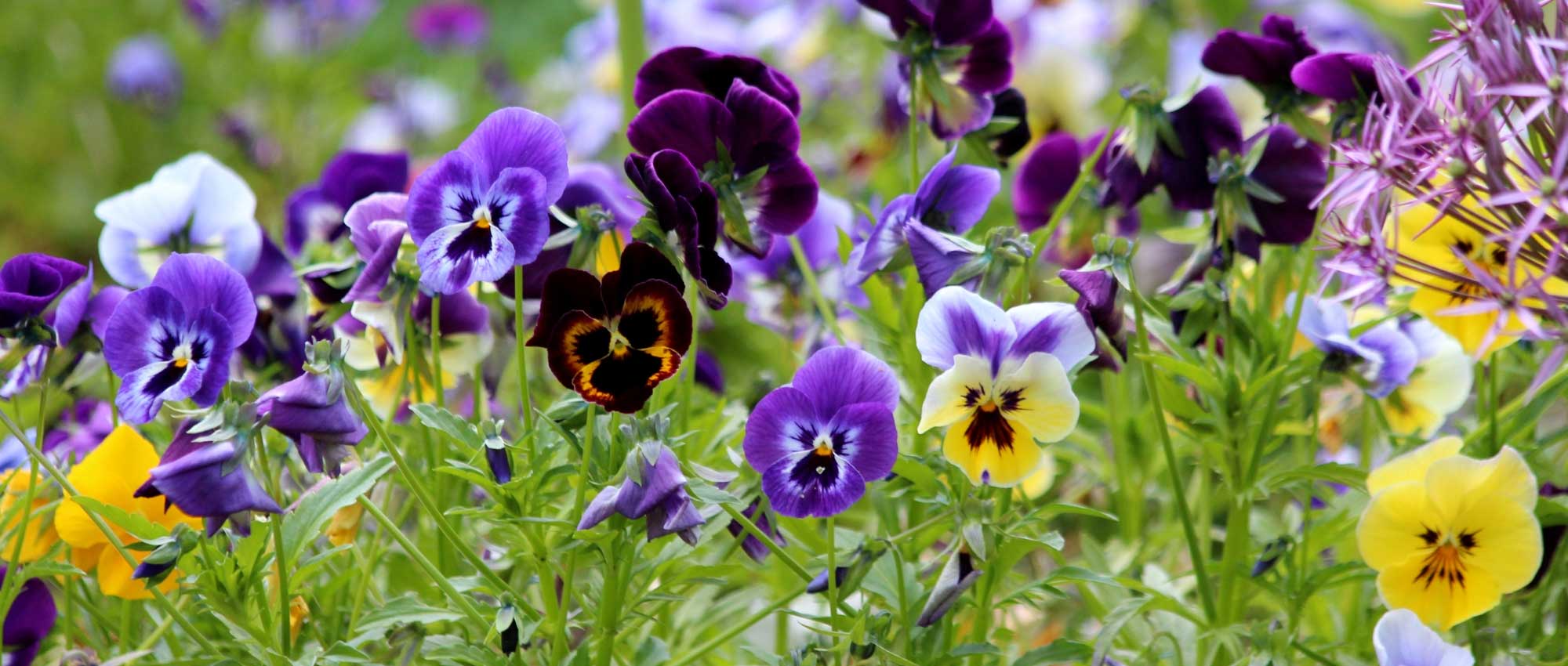
Pansies: growing, sowing, planting and care
Contents
Pansies in a nutshell
- Pansies offer a very wide palette of colours, in bright and vibrant shades
- The flowers are often large and impressive, beautifully contrasted with black
- They are easy to cultivate plants
- They provide a long flowering period, sometimes in autumn and winter
- Pansy is one of the best plants for window boxes and floral arrangements in pots
- It is perfect for decorating balconies, terraces, and window sills, but also finds its place in the garden, in open ground
A word from our Expert
Pansies are delightful herbaceous plants that charm us with their large, colourful flowers. They are ideal for window boxes, to enhance a balcony or windowsill. They are perennial plants but are generally grown as annuals or biennials. Their flowers consist of broad, rounded petals, often marked with darker spots. They are often bicoloured. The most common are garden pansies, Viola x wittrockiana, which include numerous hybrids bearing large flowers in vibrant shades.
Pansies are appreciated for their very colourful flowers, to which the dark macules add a lot of charm. They offer a rather unique flowering, easily recognisable. Pansies have the advantage of being able to flower even in autumn and winter, when flowers are scarce! Moreover, the flowering generally lasts quite a long time.
Pansies are easy plants, suitable for beginner gardeners. They require little care, especially if planted in the ground, while providing a generous display of flowers. You can start their cultivation from young plants or seeds. Pansy is the perfect plant for window boxes: floriferous, colourful, compact, easy…! It offers a wide range of colours, allowing for varied combinations, and pairs very well with spring bulbs. Additionally, their flowers are edible and can, for example, be added to salads to bring a touch of originality and colour. Discover all our tips for successfully sowing, planting, and caring for pansies!
Botany
Botanical data
- Latin name Viola sp.
- Family Violaceae
- Common name Pansy
- Flowering spring, summer, autumn or winter, depending on the varieties and the sowing/planting date
- Height between 10 and 20 cm
- Exposure sun or partial shade
- Soil type rich in humus, cool, well-drained
- Hardiness around -15 °C
The pansies, belonging to the genus Viola, encompass nearly 500 species native to temperate zones of the Northern Hemisphere. Those cultivated in gardens are generally small herbaceous plants. In the wild, there are annual, perennial pansies, and even small bushes. They have a very wide global distribution. They can be found in temperate regions, in America (North and South), Europe, Asia, Australia, New Zealand… In nature in France, there are 39 species, including Viola tricolor, Viola odorata, Viola cornuta… They are mainly found in undergrowth and forest edges, sometimes in meadows.
The Viola genus is extremely diverse, in terms of shapes, colours, life cycles (annual, biennial, perennial…) or flowering periods. The pansies found today in gardens have been heavily hybridised. They are derived from hybridisations mainly involving Viola tricolor (the wild pansy), as well as Viola lutea, Viola altaica and a few other species. Garden pansies are generally grouped under the name Viola x wittrockiana. They are also known as Giant Swiss Pansies. They offer large and impressive flowers. The Viola cornuta, or Horned Violets, are also commonly cultivated in gardens. Their flowers are smaller and more delicate.
Viola x wittrockiana is named after the Swedish botanist Veit Brecher Wittrock (1839–1914), former director of the botanical garden of Stockholm and a specialist in pansies.
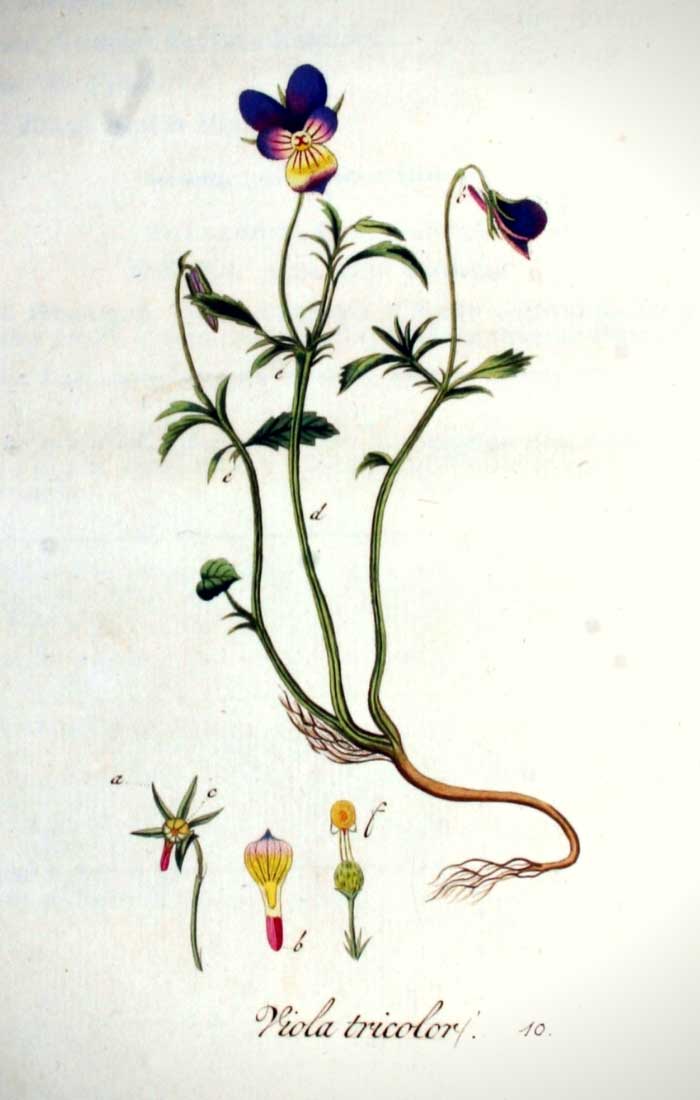
Viola tricolor (Wild pansy, ancestor of the cultivated pansy): Botanical plate
The pansy, or Viola, has given its name to the family of Violaceae (over 800 species), to which it belongs. This family mainly includes tropical plants, often trees and lianas. The Viola represent more than half of the species in this family!
Pansies began to be cultivated and hybridised in the early 19th century, driven by Lady Mary Elizabeth Bennet (1785–1861), who was the first to collect a large number and make crossings. By the end of the 1830s, the first varieties appeared with a large black blotch (instead of the stripes, called “whiskers”, on the original species). Pansies quickly became very popular.
The pansies found in gardens are mainly short-lived perennials, but they are usually grown as annuals or biennials. Being the result of hybridisations, the flowers are very beautiful during the first flowering, but degenerate afterwards, becoming less interesting in the following years. It is better to renew the plants regularly.
Pansies form small clumps, not very tall, growing more or less at ground level. They generally measure between 10 and 20 cm high. They can take on a trailing habit, making them very decorative in hanging displays.
Depending on the varieties (and the sowing or planting date!), pansies can bloom in spring, summer, autumn, and even winter! It is thus possible to enjoy them throughout the year by combining plants with successive flowering periods. Pansies can bloom very early in the season; they are valuable for bringing colour in winter! Moreover, they have the advantage of offering flowers over a long period.
Pansy flowers are generally solitary. They have an irregular, zygomorphic shape. They consist of five petals: one large petal at the bottom, two lateral ones, and two upper ones. They have a rounded shape. The two upper petals overlap, partially covering each other. At the base of the petals, the flowers also have five sepals that remain in place after flowering. The flower has five free stamens (male organs, bearing pollen).
Pansy flowers have a soft and warm appearance, undoubtedly due to the very rounded shapes of their petals and blotches. The edges of the petals are sometimes wavy or frilled. There are even varieties with double flowers, with a large number of petals, such as the pansy ‘Chalon Supreme Wildberry’!
In pansies, the most common shades are yellow, purple, and blue; they correspond to the colours of wild pansies, ancestors of garden pansies, Viola x wittrockiana. But the countless horticultural varieties allow for an extremely wide range of colours: yellow, orange, red, brown, blue, purple, pink, white… Flowers can even be black, as seen in the stunning variety ‘Molly Sanderson’.

The flowering of pansies can take on varied shades. From left to right, Viola wittrockiana ‘Alpha F1 Moonlight’, ‘Matrix Lavender Shades’, Viola wittrockiana Rose with blotch, ‘Matrix Solar Flare’, ‘Sorbet True Blue’
Garden pansies, Viola x wittrockiana, offer impressive, highly contrasting blooms, often with large black blotches in the centre, which can resemble a face. The flowers measure between 5 and 8 cm in diameter. Those from the Colossal series even exceed 10 cm in diameter! The flowers of wild, botanical pansies are much smaller and more delicate. It is the work of hybridisation, begun in the 19th century, that has allowed for the selection of highly appreciated varieties for their large flowers and their black blotch in the centre, giving the bloom more contrast and intensity.
The style is very different, between large-flowered, impressive pansies and small-flowered varieties, such as Viola cornuta, which appear much more delicate and natural. Similarly, pansies with large black blotches immediately attract the eye, while those with stripes have a more delicate and discreet appearance.
In most varieties, the flowers do not have much of a scent. However, a few are pleasantly fragrant, such as the pansy ‘Etain’.
Pansy flowers are edible! They are perfect for decorating salads, for example. The variety Viola wittrockiana ‘Tasty F1’ is particularly appreciated for its taste qualities.
Pansy leaves can take on quite variable shapes. They are alternate, simple, undivided. They are generally elliptical or ovate, with the edge of the lamina being dentate or crenate. The leaves measure between 2 and 5 cm in length. They bear stipules (leaf-like appendages, inserted at their base), sometimes well-developed. The leaves are of a medium or dark green, very ordinary.
After flowering, the plant produces capsules that open in three valves. They then release the small, rounded, brown seeds. When drying, the capsules can eject the seeds quite far, up to several metres. Some species have elaiosomes, growths appreciated by ants, which come to collect the seeds and help disperse them!
Pansies can self-seed. However, as they are often horticultural varieties, the flowers from the seedlings are likely to be different from the original plant.
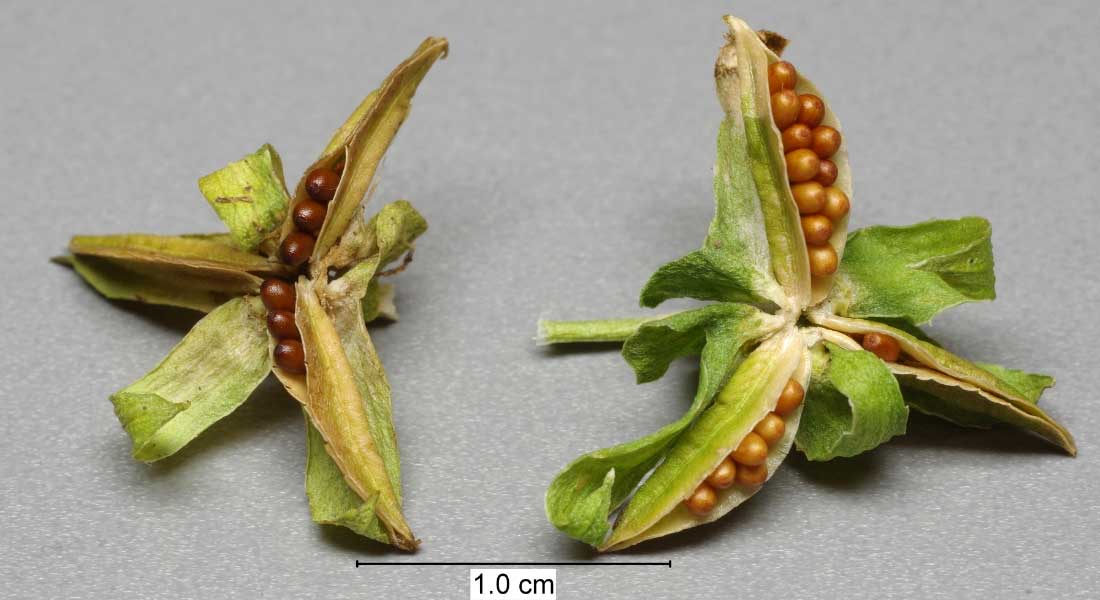
The fruits and seeds of Viola x wittrockiana (photo Berthold Werner)
Read also
Plant biennials in plug plantsThe varieties
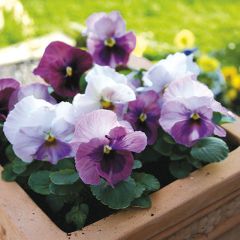
Viola Alpha F1 Pink Shades - Medium-flowered Pansy
- Flowering time March to October
- Height at maturity 15 cm
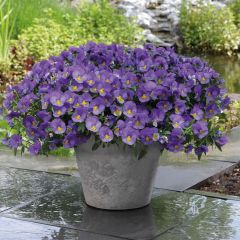
Viola x wittrockiana Cool Wave Blue Skies - Pansy
- Height at maturity 20 cm
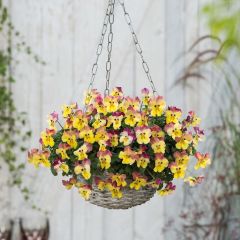
Viola wittrockiana Cool Wave Pink Yellow Bicolour- Swiss Garden Pansy
- Height at maturity 20 cm
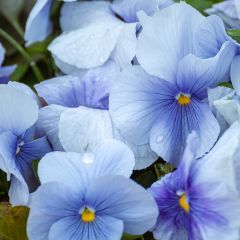
Viola x wittrockiana Inspire Silver Blue - Pansy
- Flowering time February to June
- Height at maturity 20 cm
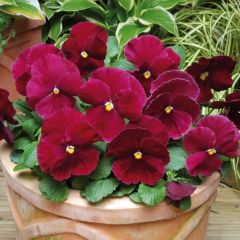
Viola Matrix Rose - Pansy
- Flowering time April to November
- Height at maturity 20 cm

Viola hybrida Inspire F1 Orange Blotch - Pansy
- Flowering time April to December
- Height at maturity 15 cm

Viola cornuta Molly Sanderson
- Flowering time May to October
- Height at maturity 15 cm
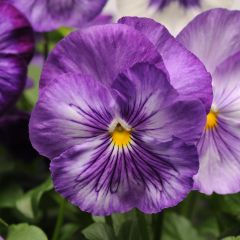
Viola hybrida Matrix F1 Lavender Shades - Pansy
- Flowering time April to November
- Height at maturity 20 cm
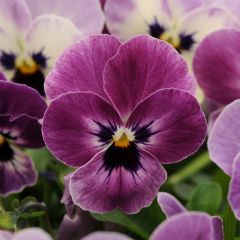
Viola Sorbet XP Raspberry - Horned Pansy
- Height at maturity 15 cm
Discover other Pansies and violas
View all →Available in 2 sizes
Available in 2 sizes
Available in 1 sizes
Available in 2 sizes
Available in 2 sizes
Available in 1 sizes
Available in 1 sizes
Available in 1 sizes
Available in 1 sizes
Available in 2 sizes
Planting pansies
Where to plant?
Plant pansies in full sun or partial shade. It is best to avoid scorching sunlight. If you live in the south of France, it is better to place pansies in light shade, as they do not cope well with summer heat, which may interrupt flowering. They prefer relatively cool, mild temperatures.
Pansies are ideal in containers, on a balcony or a windowsill. They add a lovely splash of colour! You can even hang them, especially since some pansies have a trailing habit. However, they also find their place in the ground, in a flower bed or mixed border. The varieties with small flowers will create a rather natural effect. Planted in large groups, pansies can form a beautiful carpet of flowers, which you can sprinkle with a few spring-flowering bulbs. Pansies can also be grown in rockeries, and even on walls, if you provide a small pocket of substrate!
They enjoy soils that remain cool in summer, but are also well-drained. Pansies are sensitive to stagnant moisture, which can cause them to rot. If your soil tends to retain water, you can add gravel or coarse sand to facilitate water infiltration deep into the soil.
Pansies will thrive in fertile soil, rich in humus. It is advisable, when planting, to add well-decomposed potting soil or compost to enrich the soil. They prefer light, loose soil. They also favour neutral or acidic soils rather than calcareous substrates.
When to plant pansies?
We sell pansies as plug plants: for optimal results, plant them as early as September so they can establish before winter; this is particularly true for the trailing pansies from the ‘Cool Wave’ series.
If you were unable to do this in autumn, it is also possible to plant pansies in early spring, around April.
How to plant?
For planting in the ground:
We suggest planting pansies in groups rather than individually. You can take the opportunity to create flower carpets, for example. Maintain a distance of about 20 cm between plants (to be adjusted according to the size of the variety being grown).
- Start by placing the plug in a basin filled with water. This helps to rehydrate it well and ensures better establishment.
- Prepare the ground: remove weeds, break up the larger clumps, and add some potting soil or compost.
- Dig a planting hole.
- Plant the plug ensuring that the collar is level with the soil.
- Fill in by replacing the soil all around and firm it down with the flat of your hand.
- Water generously.
Water regularly during the first few weeks until they are well established.
We also recommend applying a mulch around them to prevent the soil from drying out too quickly.
For planting in pots or containers:
- Choose a sufficiently large container, a large pot or a hanging basket.
- Place a drainage layer at the bottom (broken pots, gravel…) to allow water to drain away properly.
- Fill the pot with potting soil.
- Install the plant, then replace the soil around it and firm it down.
- Water.
You can also sow pansies, but it is simpler and quicker to buy young plants directly.
Also, check out our advice sheet – Planting biennials as plug plants
 You can plant pansies in the ground, for example, to create a carpet of flowers, with spring-flowering bulbs. You can also grow them in pots or hanging baskets.
You can plant pansies in the ground, for example, to create a carpet of flowers, with spring-flowering bulbs. You can also grow them in pots or hanging baskets.
Care
Pansies require very little maintenance. Water in summer if the weather is dry, once or twice a week. Ensure regular watering if you are growing them in pots or containers, as the substrate dries out quickly. However, avoid overwatering, which could cause the plant to rot and lead to diseases. For the same reasons, direct the spray towards the soil without wetting the foliage, and preferably water in the morning.
We suggest, especially for those that flower in winter, to place a layer of mulch (dead leaves, wood chips, linseed flakes…) around them to protect them from the cold.
Although they are often grown as annuals or biennials, you can keep your pansies for several years, but their flowering is generally more beautiful in the first year than in subsequent years.
It is best to remove faded flowers, as this encourages the plant to produce new ones, potentially extending the flowering period! This also prevents the plant from spending its energy on producing seeds.
Pansies can be attacked by slugs and snails. You can use a slug repellent, such as Ferramol, or make a slug trap. Sometimes aphids also target pansies. These insects pierce the plant’s tissues to extract sap, which weakens it. We recommend spraying black soap on the foliage.
Regarding diseases, pansies are particularly sensitive to rust and downy mildew. Rust is a disease caused by a fungus, favoured by humidity and poor air circulation. When the plant is affected, its foliage bears rust-coloured spots. It is an unsightly disease that weakens the plant, but its survival is rarely threatened. Remove and burn the affected leaves, then spray with a horsetail decoction. Downy mildew is also a fungal disease, recognised in pansies by the appearance of yellow spots on the upper side of the leaves and a grey fluff on the underside. It is favoured by mild temperatures combined with high humidity. You can use a sulphur-based solution or a horsetail decoction. Also, remember to space out your waterings.
Propagation
Pansies are primarily propagated by sowing, but they can also be divided or propagated by cuttings. Vegetative propagation techniques (division, cuttings) have the advantage, compared to sowing, of guaranteeing new plants identical to the original variety.
Sowing
You can stagger your sowings so that your plants flower at different times. Sow preferably in summer, between June and August, to obtain flowers in autumn and winter. You can also sow in late winter, around February, under a cold frame, for flowering in spring and summer.
- Prepare a seed tray or container by filling it with special seed compost. Firm it down lightly and level the substrate.
- Spread the seeds on the surface.
- Cover them very lightly (a few millimetres is sufficient) with sifted compost, then gently firm down.
- Water with a fine spray. You may use a sprayer if desired.
- Place the seed tray in a bright location, out of direct sunlight. If you have sown in late winter, place it under a frame.
We recommend watering regularly, at least once a week, or even twice.
You can transplant the pansies into individual pots about a month later; then plant them in the ground in early autumn (in the case of a summer sowing).
If you leave the faded flowers in place, the pansy may self-seed. Over time and generations, it will tend to revert to its wild form (smaller flowers, without black markings, etc.).
Tuft Division
You can divide your pansies to obtain new plants. We recommend doing this in autumn, although it can also be done in spring. This helps to rejuvenate the plants, which otherwise tend to become exhausted and stop flowering much.
- Choose a well-developed clump. Carefully dig it up, digging wide enough not to damage the root system.
- Separate the clump into several parts, ensuring that each has roots.
- Replant each fragment immediately in a new location, after preparing the ground.
- Water generously.
→ Learn more in our tutorial: How to divide pansies?
Propagation by Cuttings
Although this technique is not widely used, it is possible to propagate pansies by cuttings. In summer, take a segment of stem about 5 cm long. It should not have any flowers. Remove the leaves from the base, leaving only those at the top. Plant the stem in a pot filled with compost, and firm it all around. Keep the substrate slightly moist until the cutting roots.
Pairing Pansies in the garden
Pansies are an ideal plant for containers, adding colour to a balcony or windowsill. Choose varieties with bright hues and pair them with other colourful flowers: Bellis, primroses, forget-me-nots, wallflowers… You can add heucheras for their highly decorative foliage. Pansies are perfect for creating compositions, whether in a large pot or a container, for example with spring bulbs: tulips, hyacinths, daffodils, muscari…
You can also achieve a fairly natural-looking container by incorporating some grasses, such as Carex or Pennisetum. In this case, choose pansies in soft shades, and plant them alongside Muehlenbeckia, ipheion, muscari, Cyclamen coum…
With a wide range of horticultural varieties available in various shades, pansies allow for stunning colour combinations! Play with colours, and you will easily find plants that complement the hues of the pansies, enabling you to create very different atmospheres depending on your choices.
For example, you can create a beautiful composition in warm tones by pairing orange pansies with the blooms of ‘Orange Princess’ tulip, highlighted by the dark foliage of ‘Amethyst Myst’ heuchera. For a composition in blue tones, place deep blue pansies alongside the small flowers of muscari and forget-me-nots, along with the intense and deep blooms of ‘Queen of The Night’ tulip.
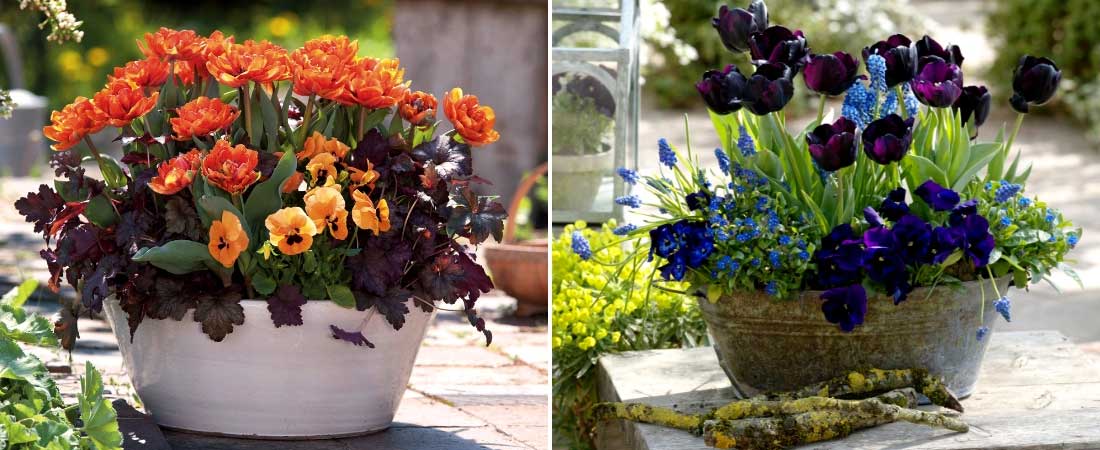
Pansies allow for beautiful floral compositions! ‘Orange Princess’ tulip, ‘Amethyst Myst’ heuchera, and orange pansy with black blotch / ‘Queen of the Night’ tulip, muscari, and pansies (Photos: Friedrich Strauss- Biosphoto)
However, do not think that pansies are only suited for pot or container cultivation! You can also plant them in borders or beds, especially with bulbous plants. Create a stunning spring scene by combining pansies with early bulbs, such as tulips, daffodils, chionodoxa, crocuses, hyacinths… You can dress the base of deciduous trees by forming a carpet of pansies among which you will scatter spring bulbs. Feel free to pair pansies with small grasses like Carex morrowii or Hakonechloa macra. Also, enjoy the flowering of primroses! At the front of a bed, you can create a very bright scene by combining, for example, white-flowered pansies like ‘Matrix White’, with the elegant blooms of ‘Hibernia’ tulip and the variegated foliage of ‘Silver Crown’ hostas.
Viola and small-flowered pansies can find their place in a fairly natural bed! Pair them with decorative foliage and delicate blooms: hostas, ferns, forget-me-nots, muscari…
Finally, remember that you can combine different varieties of pansies to enjoy their blooms for longer! This way, they will succeed each other. Similarly, you can plant together varieties in different colours, for example, orange-flowered pansies with others in red or yellow, for a warm-toned bed.
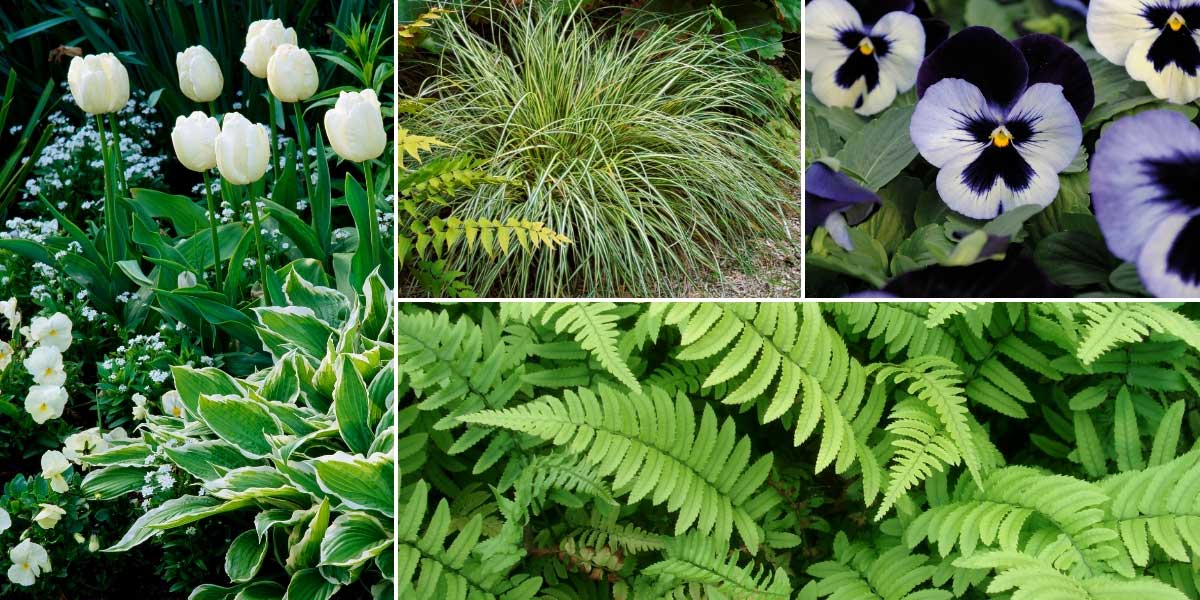 Pansies also allow for beautiful scenes in open ground. ‘Hibernia’ tulip, ‘Matrix White’ pansy, and ‘Silver Crown’ hosta (Photo: Clive Nichols – MAP) / Carex morrowii ‘Variegata’ / Viola wittrockiana ‘Alpha F1 Moonlight’ / Dryopteris cycadina
Pansies also allow for beautiful scenes in open ground. ‘Hibernia’ tulip, ‘Matrix White’ pansy, and ‘Silver Crown’ hosta (Photo: Clive Nichols – MAP) / Carex morrowii ‘Variegata’ / Viola wittrockiana ‘Alpha F1 Moonlight’ / Dryopteris cycadina
Did you know?
- An edible flower
Pansy flowers are edible and perfect for decorating salads or desserts! The Viola ‘Tasty F1’ has been specifically selected for its flavour. It is also possible to crystallise the flowers. To do this, simply take the petals, brush them with beaten egg white, then dip them in fine sugar and let them dry. Wild pansy (Viola tricolor) is also a medicinal plant. It is particularly effective for skin problems.
- Symbolism
The pansy was named in the 15th century, derived from a similar word in French, evoking memory and reflection. It received this name because the flower can resemble a face, and when it is tilted towards the ground, it evokes a person deep in thought. This flower has been a symbol of free thought, a thought liberated from any religious or social dogma (it was the emblem of the Free Thinkers Society). The pansy flower is also a symbol of love and consideration towards someone. In the language of flowers, its meaning varies depending on its colour.
- Pansies or violets?
These plants are very close; they all belong to the genus Viola. Those referred to as “violets” have small flowers with generally three petals pointing downwards and two upwards. The flowers are usually blue-violet in colour, with a relatively uniform shade. Pansies have larger, more colourful, and more impressive flowers. They can come in a wide range of hues. They typically have one large, well-developed petal pointing downwards, often with a dark maculate mark, and four petals pointing upwards.
Pansies are generally large-flowered horticultural hybrids, grown as annuals or biennials, while violets are closer to botanical species (wild plants) and are perennials.
Useful resources
- Discover our range of Pansies!
- Our seeds of pansies
- Discover our ideas to combine pansies
- Our tips for growing pansies in pots or containers
- Our tutorial: How to sow pansies?
- An article by Pierre on our blog – Biennials, (finally) the time for renewal!
- Our advice sheet – Planting biennials in plug plants
- Our advice sheet on biennial plants
- Our advice sheet: pansies, how to choose them well in 4 points?
- What if you tried them in the kitchen? Learn more in Edible flowers: pansies join the kitchen!
Frequently asked questions
-
The leaves of my pansies are holey and perforated. Why?
They are probably being eaten by gastropods - slugs and snails. You can make a slug trap, or place ashes or sawdust around your young plants to prevent them from reaching the foliage.
-
The leaves of my pansies have small orange spots.
They are affected by rust, a fungal disease. Remove the affected leaves, then treat with a horsetail decoction.
-
The leaves have pale yellow spots. Why?
Your plant is likely affected by downy mildew (Peronospora violae). This disease, caused by a fungus, is favoured by a combination of mild temperatures and high humidity levels. Light yellow spots, sometimes slightly brown, appear on the leaves, along with a grey fluff on the underside. The leaves wilt and the flowers fade. We advise you to limit watering, remove the affected leaves, and treat with a fungicidal.
- Subscribe!
- Contents
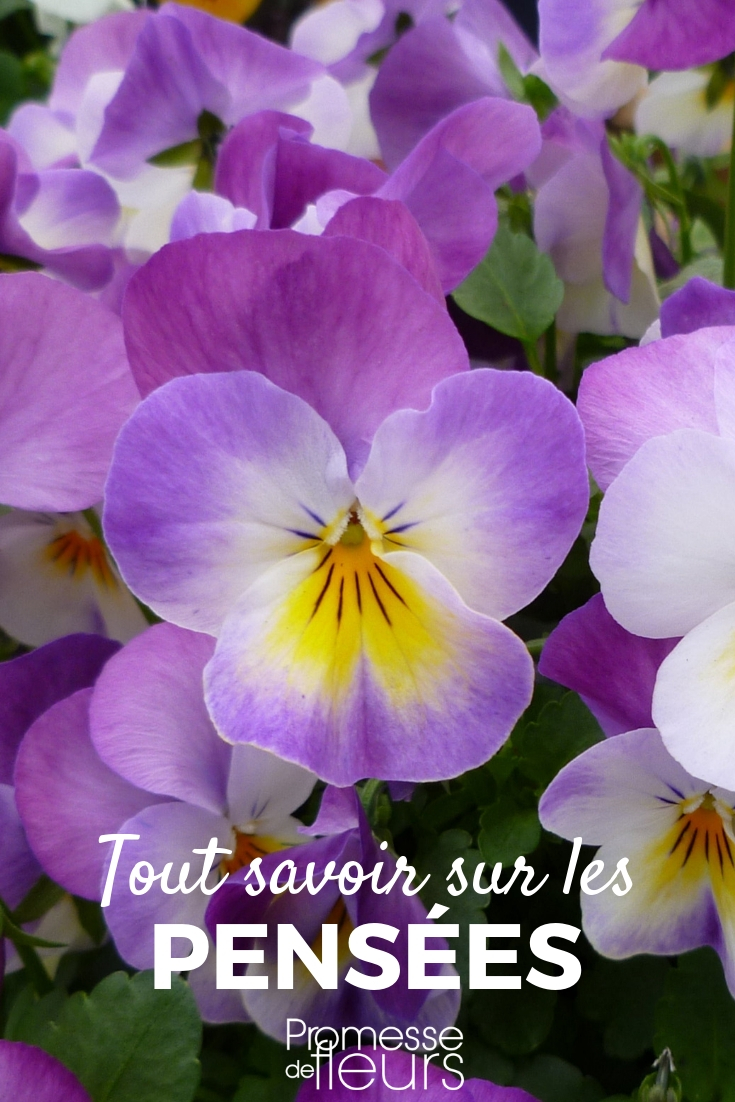































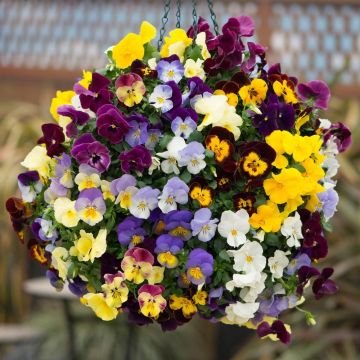
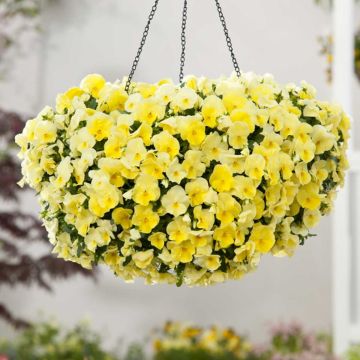
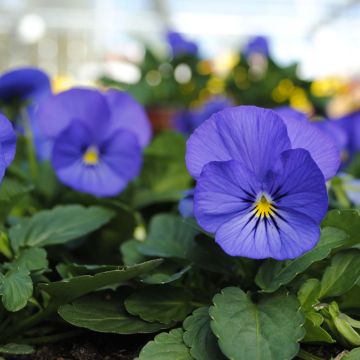
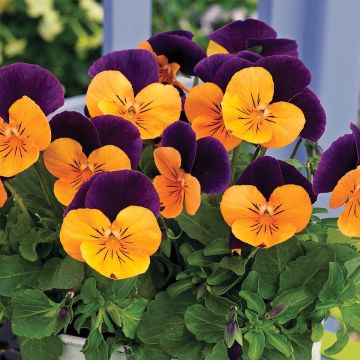
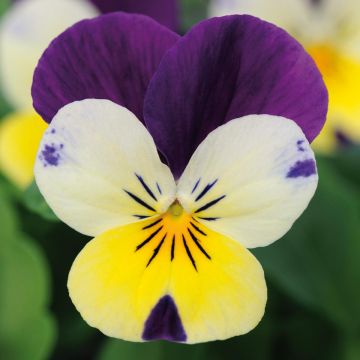
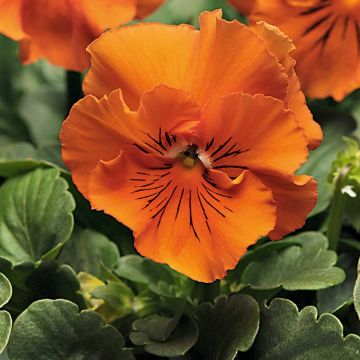
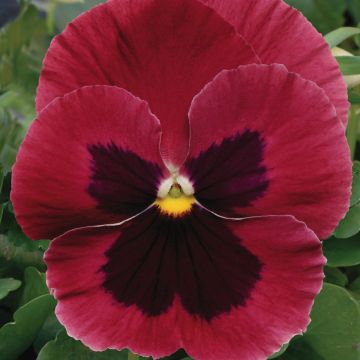
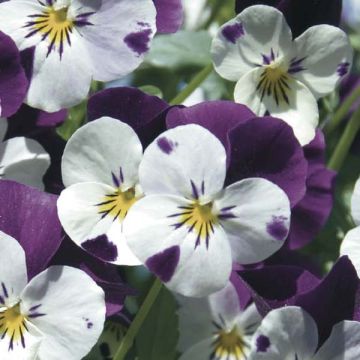
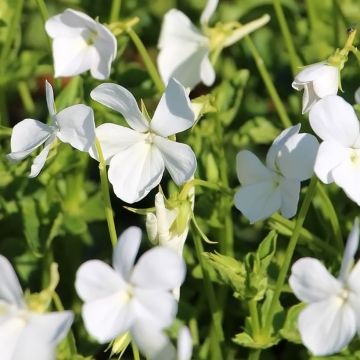

Comments